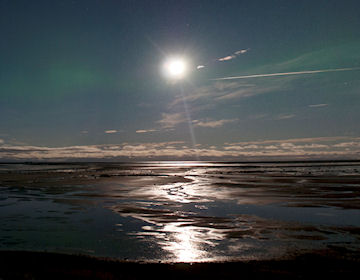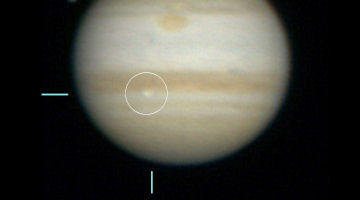AURORA ALERTS: Did you miss the Northern Lights? Next time get a wake-up call from Space Weather PHONE | | | SOMETHING FISHY: According to folklore, tonight's full Moon is the Sturgeon Moon, named by Native American tribes of the Great Lakes who caught lots of sturgeon during the month of August. A moon named after an ancient slimy fish? Go outside and take a look. It's prettier than it sounds. AURORA ALERT: A solar wind stream is buffeting Earth's magnetic field and causing geomagnetic activity around the poles. Sævar Helgi Bragason sends this picture from Bardastrond, Iceland: 
Photo details: Nikon D80, ISO 200, 10s exposure
"It was a beautiful evening in the west fjords of Iceland," says Bragason. "The auroras were easily visible even with the full Moon illuminating the scene over Snaefellsnes and Breidafjordur. Jupiter may be seen in the panorama hanging low but shining brightly. What a wonderful autumn sky!" High-latitude sky watchers should remain alert for auroras as the solar wind continues to blow. more images: from Dave Swartz of Toolik Lake, Alaska; from Sylvain Serre of Salluit, Nunavik, Quebec, Canada; FIREBALL ON JUPITER: On August 20th at 18:22 UT, two amateur astronomers in Japan independently recorded an apparent impact on Jupiter. Masayuki Tachikawa of Kumamoto city was first to report the event. His movie of the fireball shows the fireball scintillating (twinkling) along with other features on the planet -- persuasive evidence that this is a genuine event on Jupiter. Soon after Tachikawa made his report, Tokyo amateur astronomer Kazuo Aoki realized that he had recorded the fireball, too: 
The ~800 km separation of the two observers rules out an event near Earth and reinforces the association of the fireball with Jupiter. The most likely explanation: A small comet or asteroid hit the giant planet. This is the third time in only 13 months that amateur astronomers have detected signs of impact on Jupiter. The earlier events occured on July 19, 2009, and June 3, 2010. Jupiter is getting hit more often than conventional wisdom would suggest, leading many researchers to call for a global network of telescopes to monitor Jupiter 24/7 and measure the impact rate. "Like the event of June 3rd, this fireball did not produce any visible debris," notes John Rogers, director of the British Astronomical Association's Jupiter section. "Here are some hi-resolution images taken 1-2 rotations before and 1-2 rotations after the event. As the observers commented, there was no visible mark (not in RGB, nor UV, nor methane), post-impact. Dark brown spots on the North Equatorial Belt were already there before the fireball."
August 2010 Northern Lights Gallery
[previous Augusts: 2009, 2008, 2007, 2006, 2005, 2004, 2003]
2010 Perseid Photo Gallery
[meteor radar] [Perseid fireball cam] | 
